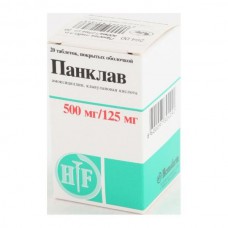Expiration date: 04/2025
Composition and form of issue:
Tablets, film-coated. 1 tablet contains:
amoxicillin (in the form of trihydrate amoxicillin) 250 mg
clavulanic acid (in the form of potassium clavunate) 125 mg
excipients: silicon dioxide colloidal sodium carboxymethyl starch MCC magnesium stearate
shell: hypromellose propylene glycol titanium dioxide E171
in a Bank of dark glass 15 PCs., in a pack of cardboard 1 Bank.
Tablets, film-coated. 1 tablet contains:
amoxicillin (in the form of trihydrate amoxicillin) 500 mg
clavulanic acid (in the form of potassium clavunate) 125 mg
excipients: silicon dioxide colloidal sodium carboxymethyl starch MCC magnesium stearate
shell: hypromellose propylene glycol titanium dioxide E171
in a Bank of dark glass 20 PCs., in a pack of cardboard 1 Bank.
Description of dosage form:
250/125 mg tablets: oval, biconvex tablets, coated with a white film.
Tablets 500/125 mg: tablets are oval, biconvex, film-coated white color, with the image of the letters "A" and "K" and scored on one side.
Pharmacokinetics:
The main pharmacokinetic parameters amoxicillin and clavulanic acid are similar. Both components are rapidly absorbed after ingestion, eating has no effect on absorption. Cmax plasma achieved through 1 h after administration.
Characterized by a good volume of distribution in the body fluids and tissues (lungs, middle ear, pleural and peritoneal fluid, uterus, ovaries, etc.). Amoxicillin also penetrates the synovial fluid, liver, prostate gland, Palatine tonsils, muscle, gall bladder, the secret of the sinuses, saliva, bronchial secret.
They do not penetrate the BBB with unhealed meninges, penetrate the placental barrier and are excreted in breast milk in trace concentrations.
Amoxicillin and clavulanic acid are characterized by low plasma protein binding.
Amoxicillin is partially metabolized, clavulanic acid is subjected to intensive metabolism.
Amoxicillin is excreted by the kidneys almost unchanged by tubular secretion and glomerular filtration, clavulanic acid — by glomerular filtration, partly in the form of metabolites. Small amounts are excreted by the intestines and lungs. T1/2 amoxicillin and clavulanic acid — 1-1.5 hours in patients with severe renal insufficiency T1 / 2 increases to 7. 5 hours for amoxicillin and to 4. 5 hours — for clavulanic acid.
Both components are removed with hemodialysis and in small quantities — with peritoneal dialysis.
Description of the pharmacological action:
It is a combination of amoxicillin-semisynthetic penicillin with a broad spectrum of antibacterial activity and clavulanic acid — an irreversible inhibitor of beta-lactamases (II, III, IV, V type is inactive against type I). Clavulanic acid forms a stable inactive complex with the specified enzymes and protects amoxicillin from the loss of antibacterial activity caused by the production of & beta-lactamase, as the main pathogens and co-pathogens, and opportunistic microorganisms. This combination provides a high bactericidal activity of the drug.
Panklav has a wide range of antibacterial action. Active against both amoxicillin-sensitive strains and strains producing & beta-lactamase:
Gram-positive aerobes: Streptococcus pneumoniae, Streptococcus pyogenes, Streptococcus viridans, Streptococcus bovis, Staphylococcus aureus (except methicillin-resistant strains), Staphylococcus epidermidis (except methicillin-resistant strains), Listeria spp., Enterococcus spp.
Gram-negative aerobes: Bordetella pertussis, Brucella spp., Campylobacter jejuni, Escherichia coli, Gardnerella vaginalis, Haemophilus influenzae, Haemophilus ducreyi, Klebsiella spp., Moraxella catarrhalis, Neisseria gonorrhoeae, Neisseria meningitidis, Pasteurella multocida, Proteus spp., Salmonella spp., Shigella spp., Vibrio cholerae, Yersinia enterocolitica.
Anaerobes: Peptococcus spp., Peptostreptococcus spp., Clostridium spp., Bacteroides spp., Actinomyces israelii.
Indications:
Infectious and inflammatory diseases caused by sensitive to the combination of amoxicillin/clavulanic acid strains:
- upper respiratory tract and ENT-organs (acute and chronic sinusitis, acute and chronic otitis media, tonsillitis, pharyngitis)
- lower respiratory tract (acute and chronic bronchitis and pneumonia, pleural empyema)
- urinary tract (including cystitis, urethritis, pyelonephritis)
- bone tissue and joints (including chronic osteomyelitis)
- the skin and soft tissues (i.e. cellulitis, wound infection)
- biliary tract (cholecystitis, cholangitis)
- sexually transmitted diseases (gonorrhea, chancroid)
- gynecological infections (including salpingitis, salpingoophoritis, endometritis, septic abortion)
- odontogenic infections.
Contraindications:
- hypersensitivity to the components of the drug (including cephalosporins and other beta-lactam antibiotics)
- infectious mononucleosis (including the appearance of morbilliform rash)
- children under 12 years of age.
With caution:
- pregnancy
- lactation
- severe hepatic insufficiency
- diseases of the gastrointestinal tract (including history of colitis associated with the use of penicillins)
- chronic renal failure.
Application for pregnancy and breastfeeding:
During pregnancy can be used when the benefit of its use is much higher than the risk that exists when using any drug during pregnancy.
If necessary, the use of the drug during lactation breastfeeding is suspended.
Side effect:
From the digestive tract: nausea, vomiting, diarrhea, impaired liver function, increased activity of hepatic transaminases, stomatitis in isolated cases — a moderate asymptomatic increase in liver enzymes and SCF, cholestatic jaundice, hepatitis, pseudomembranous colitis.
Allergic reactions: urticaria, erythematous rash rarely-erythema multiforme, anaphylactic shock, toxic epidermal necrolysis, acute generalized exanthematous pustules, serum disease, Quincke edema, Stevens-Johnson syndrome very rarely-exfoliative dermatitis.
From the Central nervous system: dizziness, headache, convulsions (may occur in violation of kidney function or in patients receiving high doses of pancake).
Other: candidiasis of the skin and mucous membranes, the development of superinfection, reversible increase in PV, vaginitis, interstitial nephritis.
Drug interaction:
Antacids, glucosamine, laxatives, aminoglycosides-slow down and reduce the absorption of ascorbic acid-increases.
Bactericidal antibiotics (including aminoglycosides, cephalosporins, cycloserine, vancomycin, rifampicin) have a synergistic effect bacteriostatic drugs (macrolides, chloramphenicol, lincosamides, tetracyclines, sulfonamides) — antagonistic.
Increases the effectiveness of indirect anticoagulants (suppressing intestinal microflora, reduces the synthesis of vitamin K and prothrombin index). While receiving anticoagulants should monitor blood-clotting factor.
Reduces the effectiveness of oral contraceptives, LS, during the metabolism of which is formed PABK, ethinyl estradiol-the risk of bleeding "breakthrough".
Diuretics, allopurinol, phenylbutazone, NSAIDs and other drugs that block tubular secretion, increase the concentration of amoxicillin (clavulanic acid is excreted mainly by glomerular filtration).
Allopurinol increases the risk of skin rashes.
Method of application and doses:
Inside, during a meal, not liquid, squeezed small amount of liquid.
Adults and children over 12 years (or weighing more than 40 kg) usual dose — 1 table. 250 mg / 125 mg 3 times a day (mild to moderate infection).
In severe infection - 2 tables. 250 mg / 125 mg or 1 table. 500 mg / 125 mg 3 times a day.
The maximum daily dose of clavulanic acid (in the form of potassium salt) for adults-600 mg, for children-10 mg / kg.
The maximum daily dose of amoxicillin is 6 g for adults and 45 mg/kg for children.
The course of treatment-5-14 days, the duration of the course is determined by the doctor. Treatment should not last more than 14 days without re-medical examination.
In odontogenic infections: 1 table. 500 mg / 125 mg every 12 h for 5 days.
In moderate renal insufficiency (Cl creatinine 10-30 ml/min) - 1 table. 500 mg / 125 mg every 12 h or 1 table. 250 mg / 125 mg 2 times a day (with mild to moderate course) in severe renal failure (Cl creatinine <10 ml/min) — 1 table. 500 mg / 125 mg every 24 h or 1 table. 250 mg / 125 mg 1 time a day (with light and moderate flow).
When anurii the interval between doses should be increased to 48 hours or more.
Since the tablets contain different amounts of clavulanic acid 2 table. Panklav 250 mg/125 mg are not equivalent 1 table. Panklav 500 mg / 125 mg.
Overdose:
Symptoms: impaired gastrointestinal function: nausea, vomiting, possible excitement, insomnia in rare cases — seizures, as well as violation of the water-electrolyte balance.
Treatment: symptomatic therapy, with the recent admission of the drug (less than 4 h) — gastric lavage, adsorbent. Effective hemodialysis.
Special instruction:
In the course of treatment, it is necessary to monitor the state of the function of the hematopoietic organs, liver and kidneys.
In order to reduce the risk of side effects from the gastrointestinal tract should take the drug during meals.
Perhaps the development of superinfection due to the growth of insensitive to the drug microflora, which requires appropriate changes in antibacterial therapy.
In patients with hypersensitivity to penicillins, cross allergic reactions with cephalosporin antibiotics are possible.
Receiving Panklav leads to the appearance of amoxicillin in urine. The high concentration of amoxicillin give a false positive reaction for glucose in urine when using reagent Benedict or mortar of Felling. It is recommended to use enzymatic reactions with glucose oxidase.
The ability to concentrate the drug does not affect.
Panclav
(Amoxicillin
+
Clavulanic
acid)
500mg
+
125mg
20
tablets
- Brand: Hemofarm

- Availability:
in stock
Categories:
-
$11.20

